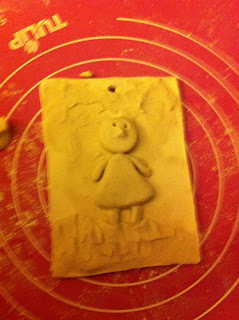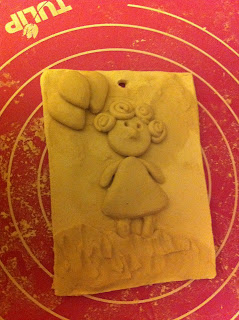This will be my final tutorial for the Creative Paperclay Company. I have enjoyed my stint doing these tutorials, but life is so busy for me that I chose not to re-apply for the current team. I wish all the new team members success, and lots of traffic to your own blog. Have fun, and best of luck!
The first thing to think about when doing an armature is 'shape'. Look at an object and see what 3-d shapes it's made of. If you can see a shape in something, then it's a simple process to replicate it.
My piglet's body is very much an egg shape, so that is the logical piece to use as a building block. Fortunately, I go to thrift stores a lot to find odd and end crafting materials for armatures as well as other work. I don't buy new styrofoam shapes, as I am very environmentally conscious, but had these on hand from a bag of junk store treasures. You could also use any other medium to build up an armature, such as aluminum foil. My foil is clean, repurposed foil. I never throw away anything that I can use in my art. It is not only cheaper, but the right thing to do. I leave a restaurant with foil neatly folded in my pocket to put through the last of the hot soapy dish water later that night. You would have to use hot glue to glue that together though. Foam can be put together with toothpicks, and bent paper clips.
The only things needed for this project are:
one 3" foam egg
one 2" foam ball
one 1" foam ball
Toothpicks or paper clips
White glue
Masking tape
Creative Paperclay
Acrylic paint

I tried to use the entire foam egg and ball. The only part that I had left over was half of the ball that I used for his snout. That went back into my supplies. I used masking tape to hold the pieces together, as well as inserting toothpicks and paper clips, because when you spread the paperclay over the armature, you want it to stay together well.

Once the armature is completely built, the only thing left to do is to spread it with paperclay. I like to spread a little white glue over the armature, and allow it to dry until it's just a bit tacky before trying to add the clay. You can do it in sections.
Then I take a piece of the clay, and try to press it relatively flat and thin with my fingers, then place it over the armature, adding others as I go, and then wetting my fingers to smooth the clay. I don't like to have to sand later, so I try to get the clay as smooth as possible. Shape the feet into hooves. Make nostrils in the snout.

The last part to make is a pair of wings if you want your pig to have them. Just a simple flat triangle, with some indentations made with the open end of an ink pen or straw, and a butter knife or small knitting needle. Let them dry separately, rather than attaching them now.
After he is dry, you can paint him whatever color you'd like. I made mine pink, but dry brushed a little cocoa color over him for a dirty pig look. Paint the wings, and after they dry, attach them with a little glue. I curled a wire and inserted it for a tail after he was finished. When you have a thinner layer of clay over something like styrofoam, it's easy to penetrate it with the wire or a needle. I took the wire out, and added some glue before re-inserting it. I later painted the wire, but when I took this photo, I was planning on making a different tail. I'm glad that I didn't, because he makes a perfect holder for a pen or pencil.

Well, folks, like Porky Pig said "Th-th-th-th-th-at's All F-f-f-f-f--f--f-olks!!!" I hope to stay in touch with all of you, so please consider following me on my:
Facebook page- https://www.facebook.com/NightmaresAndDayDreams, and on my:



















































